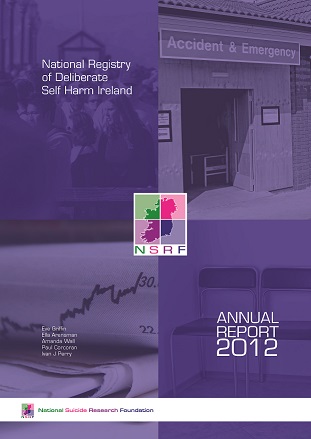Nelson, Mairea
(2014)
National Registry of Deliberate Self Harm annual report 2012.
Drugnet Ireland,
Issue 48, Winter 2013,
pp. 10-11.
The eleventh annual report from the National Registry of Deliberate Self Harm was published in September 2013.1 The report contains information relating to every recorded presentation of deliberate self-harm to acute hospital emergency departments in 2012, giving complete national coverage of cases treated.
There were 12,010 recorded presentations of deliberate self-harm, involving 9,483 individuals, in 2012. This implies that one in five (2,527, 21%) of the presentations was a repeat episode. The rate of presentations decreased from 215/100,000 of the population in 2011 to 211/100,000 in 2012, a 2% decrease.
Forty-six per cent of self-harm presentations in 2012 were men and 44% were aged under 30 years. Four hundred and sixty-nine (4%) self-harm presentations were by those living in hostels or with no fixed abode. Presentations peaked in the hours around midnight and were highest on Sundays and Mondays: 32% occurred on these two days. There was evidence of alcohol consumption in 4,610 (38%) presentations and this was more common among men (42%) than women (36%).
Drug overdose was the most common form of deliberate self-harm reported in 2012, occurring in 8,284 (69%) such episodes. Overdose rates were higher among women (75%) than among men (62%). In 70% of cases the total number of tablets taken was known; an average of 30 tablets was taken in these cases. The average among men was 32 tablets and among women 28 tablets.
Forty-one per cent of all drug overdoses involved a minor tranquilliser (most commonly benzodiazepine), 28% involved paracetamol-containing medicines, 22% involved anti-depressants or mood stabilisers (anti-depressant drugs known as Selective Serotonin Reuptake Inhibitors [SSRIs]) and 10% involved a major tranquilliser. Compared to 2011, a significant reduction was observed in the involvement of street drugs in intentional drug overdose acts, with a fall of 10% in 2012, which followed a 27% reduction in 2011. This reduction is likely to have been associated with the ban on head shop drugs from August 2010 onwards.
The next steps, or referral outcomes, for the deliberate overdose cases were: 48% discharged home; 28% admitted to an acute general hospital; 10% admitted to psychiatric in-patient care; a small proportion (3%) refused admission to hospital; and 12% discharged themselves before receiving referral advice.
The report provides information on what is being or can be done to reduce the number of self-harm cases. In January 2012, the National Office for Suicide Prevention (NOSP) established a National Working Group to continue to address access to minor tranquillisers. The authors recommend that this working group also review the implementation of the paracetamol legislation and prescribing patterns of SSRIs.
The authors report that alcohol continued to be one of the factors associated with the higher rate of self-harm presentations on Sundays, Mondays and public holidays, around the hours of midnight. These findings underline the need for ongoing efforts to:
· enhance health service capacity at specific times and increase awareness of the negative effects of alcohol misuse and abuse such as increased depressive feelings and reduced self-control;
· intensify national strategies to increase awareness of the risks involved in the use and misuse of alcohol, starting at pre-adolescent age, and intensify national strategies to reduce access to alcohol and drugs;
· educate self-harm patients and their families about the importance of reduced use of and access to alcohol; and
· arrange active consultation and collaboration between the mental health services and addiction treatment services in the best interest of patients who present with dual diagnosis (psychiatric disorder and alcohol/drug abuse).
The authors report that there was variation in the next care recommended to deliberate self-harm patients, and in the proportion of patients who left hospital before a recommendation, which ranged from 6% in the Southern Hospitals Group to 19% in the Dublin North East Hospitals Group. In 2012, a sub-group of the National Mental Health Clinical Programme Steering Group produced ‘National guidelines for the assessment and management of patients presenting to Irish emergency departments following self-harm’. The group recommended ‘that these guidelines be implemented nationally as a matter of priority’. In addition, the NOSP has funded pilot projects to implement and evaluate suicide and self-harm awareness training for all emergency department staff, and to improve assessment procedures for self-harm patients in Cork and Kerry, which is a collaborative initiative between Cork University Hospital and the National Suicide Research Foundation.
1. National Suicide Research Foundation (2013)
National Registry of Deliberate Self Harm Ireland annual report 2012. Cork: National Suicide Research Foundation.
www.drugsandalcohol.ie/20507 